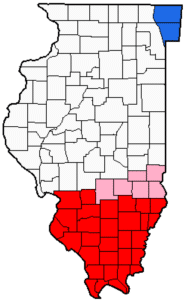
Economy:
Illinois features a diverse economic base including agriculture, manufacturing, services, banking and energy production.
Agriculture:
Illinois’s major agricultural outputs are corn, soybeans, hogs, cattle, dairy products, and wheat. In most years, Illinois is either the first or second state for the highest production of soybeans, with a harvest of 427.7 million bushels in 2008, after Iowa’s production of 444.82 million bushels. Illinois ranks second in U.S. corn production with more than 1.5 billion bushels produced annually. With a production capacity of 1.5 billion gallons per year, Illinois is a top producer of ethanol, ranking third in the United States in 2011. Illinois is a leader in food manufacturing and meat processing. In the area of The Meeting of the Great Rivers Scenic Byway, peaches and apples are grown.

Manufacturing:
Illinois is one of the nation’s manufacturing leaders, boasting annual value added productivity by manufacturing of over $107 billion in 2006. As of 2011, Illinois is ranked as the 4th-most productive manufacturing state in the country. About three quarters of the state’s manufacturers are located in the Northeastern Opportunity Return Region, with 38 percent of Illinois’s approximately 18,900 manufacturing plants located in Cook County. As of 2006, the leading manufacturing industries in Illinois, based upon value-added, were chemical manufacturing ($18.3 billion), machinery manufacturing ($13.4 billion), food manufacturing ($12.9 billion), fabricated metal products ($11.5 billion), transportation equipment ($7.4 billion), plastics and rubber products ($7.0 billion), and computer and electronic products ($6.1 billion).
Services:
By the early 2000s, Illinois’s economy had moved toward a dependence on high-value-added services, such as financial trading, higher education, law, logistics, and medicine. In some cases, these services clustered around institutions that hearkened back to Illinois’s earlier economies. For example, the Chicago Mercantile Exchange, a trading exchange for global derivatives, had begun its life as an agricultural futures market. Other important non-manufacturing industries include publishing, tourism, and energy production and distribution.
Energy:
The coal industry of Illinois has its origins in the middle 19th century, when entrepreneurs discovered coal in locations such as Sangamon County. According to the Illinois State Geological Survey, 211 billion tons of bituminous coal are estimated to lie under the surface, having a total heating value greater than the estimated oil deposits in the Arabian Peninsula. However, this coal has a high sulfur content, which causes acid rain, unless special equipment is used to reduce sulfur dioxide emissions. Many Illinois power plants are not equipped to burn high-sulfur coal. In 1999, Illinois produced 40.4 million tons of coal, but only 17 million tons (42%) of Illinois coal was consumed in Illinois. Most of the coal produced in Illinois is exported to other states and countries. In 2008, Illinois exported 3 million tons of coal, and was projected to export 9 million tons in 2011, as demand for energy grows in places such as China, India, and elsewhere in Asia and Europe. As of 2010, Illinois was ranked third in recoverable coal reserves at producing mines in the nation.
